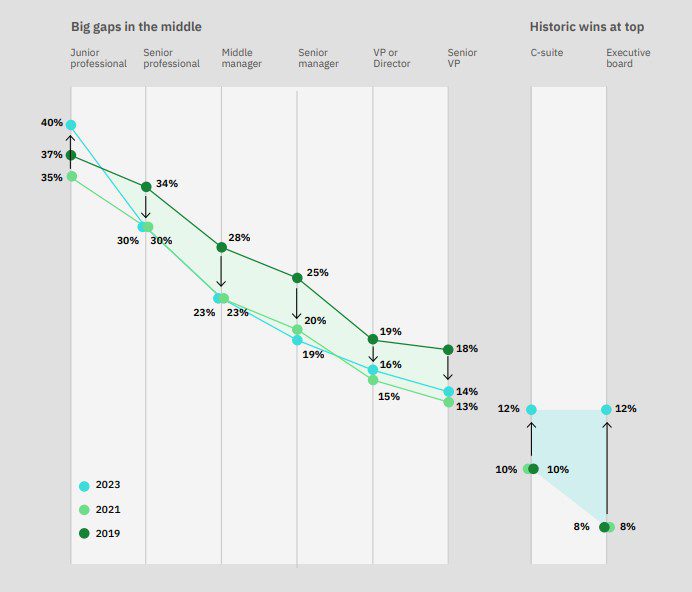Perception outpaces reality on gender equity
While there are reasons to be optimistic, organizations need to continue to take bold action around D,E&I.
Why You Should Care
The 2020s have seen progress around gender equity.
But there is still much more work to be done.
Find out what actions to take, according to IBM.
Being a diverse, equitable and inclusive (D,E&I) employer is not just the right thing to do, it is the smart thing.
This explains why the 2020s has seen significant progress around D,E&I, particularly around gender.
According to Chief and IBM’s study of 2,500 organizations in 12 countries, since 2021, the number of employers who have made advancing women into leadership roles a business priority has nearly doubled (25% in 2021 and 45% in 2023).
This has meant, since 2021, more organizations have introduced formal networking organizations for women (61% in 2023, 46% in 2021), created career development paths geared to women (78% versus 56% and now require diversity training (65% versus 25%).
These types of actions are having an impact on perceptions of gender equity at work, and driving optimism at work. But this optimism is misplaced, and it hides the continued work that needs to take place, according to IBM and Chief’s Women in Leadership report.
Workplace gender equity: The challenges and solutions
Perception of progress is outpacing the reality – gender parity may feel close, but there is still a lot of work to be done.
For instance, while there have been some huge gains around the representation at junior levels (up from 37% in 2019 to 40% now), and some “historic wins”, as IBM and Chief put it, at the C-Suite and board level, the leadership pipeline is hollowed out in the middle.
Progress at the middle management level (aka senior vice-presidents and vice-presidents) is yet to recover from pre-pandemic (14% for SVPs in 2023, compared to 18% in 2019; for VPs, 19% in 2019 versus 18% this year).

Credit: IBM x Chief, Women in Leadership report.
There remain significant structural barriers and unconscious bias that impacts women’s advancement, and therefore gender equity at work.
The problem is that “perceptions of progress around gender equity can support complacency and fatigue when bold action is needed,” Lucy Jefferys, senior partner at IBM, tells UNLEASH:
She continues: “Organizations need to ensure they are not only focused on the top, but also on the experience of work for women in the middle of their organization in order to continue to drive the progress that has been made.
“Additionally, shifting behaviors and rooting out unconscious bias won’t happen with awareness training alone.
“Using experiential learning techniques to shift biases, like shadowing, one-on-one coaching, and reverse mentoring to expose employees, and managers, especially, to the many ways gender biases could be present.”
Ultimately, employers will only reap the benefits of gender equity (the report found that successful organizations have had 19% higher revenue gains in the past two years) when they start to gender inequity see it an organizational issue – not just a women’s problem.
The report states: “Leaders need to quantify the economic gains that accrue from righting gender imbalances and adjust strategy, moving from well-intentioned pronouncements to specific gender-representation goals, directives, and metrics.”
The International Festival of HR is back! Discover amazing speakers at UNLEASH America on 26-27 April 2023.
Sign up to the UNLEASH Newsletter
Get the Editor’s picks of the week delivered straight to your inbox!

Chief Reporter
Allie is an award-winning business journalist and can be reached at alexandra@unleash.ai.